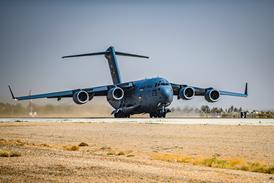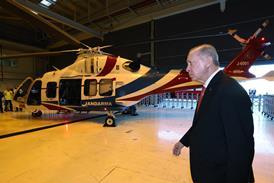Competition in the fighter market is as keen as ever, with rivals vying to fill big-ticket programmes. But will US Congress clip the F-22's export wings?
The high-profile fighter sector has grabbed many of the headlines during 2007. India at last launched a contest for 126 aircraft, while the subject of stealth - primarily in the form of the Lockheed Martin F-22 Raptor, but also through the company's F-35 Joint Strike Fighter - has exercised nations including Japan and South Korea, and prompted the US Congress to address the question of exporting such technology to its close allies.
Vision of the future? India's giant Su-30MKI could operate alongside the Eurofighter Typhoon if the type wins New Delhi's MMRCA contest |
This has been a mixed year for the JSF, with initial highs linked to a successful flight-test campaign involving the first conventional take-off and landing F-35A tempered by grounding as an electronics system anomaly cut short its 19th sortie in May, and after a ground test failure involving its Pratt & Whitney F135 engine.
Funding concerns
Budgetary pressures have also served to worry programme officials, with funding for the aircraft's alternative General Electric/Rolls-Royce F136 engine having come at the expense of some early production activities.
Aircraft AA-1 is set to resume testing soon, and the programme is preparing for the first flight of its most technologically challenging variant next May the short take-off and vertical landing F-35B. Difficult decisions must be made by some JSF partners during 2008, with the UK, for example, facing a challenge to balance its requirements for the stealthy strike aircraft against its commitment to the Tranche 3 production phase of the EurofighterTyphoon project.
Rival manufacturers are also looking to current partners Denmark and Norway, which have until now kept their options open, with interest also being maintained in the Saab Gripen and Typhoon. Boeing is also trying to promote its F/A-18E/F Super Hornet to such nations, eyeing a window of opportunity caused by possible delays to the F-35 project.
Austria earlier this year confirmed its status as the first export buyer for the Typhoon, but reduced its order from 18 to 15 aircraft, while Saudi Arabia signed a government-to-government deal in September to acquire 72 for its air force. Boeing also celebrated the first overseas sale of the US Navy's Super Hornet design, with Australia to receive 24 F/A-18Fs from 2010, with the manufacturer now eyeing a potential follow-on deal with the nation.
Saab's efforts to sell new-build or refurbished Gripens appears to have met with success on a third continent, with Thailand recently announcing its intention to buy 12 aircraft, along a similar funding model to that already used by the Czech Republic and Hungary. Dassault is still seeking its first export buyer for the Rafale, however, with Morocco - previously seen as a strong candidate - widely reported as having rejected the type in favour of Lockheed's F-16.
Marketing efforts
Russia's RSK MiG has increased its marketing efforts around the thrust-vectoring MiG-35 evolution of the MiG-29, while Sukhoi is offering an enhanced version of the Su-30-series fighter, dubbed the Su-35. China's growing presence on the international stage has also led to unconfirmed reports that Iran has moved to acquire the Chengdu J-10 fighter, prompting unease in nearby countries.
The posturing and military acquisitions of Venezuelan president Hugo Chavez have also forced Brazil to again consider its long-term fighter needs, and to revive its stalled F-X procurement plans. The project is expected to attract similar bidders to those contesting the Indian requirement, although Russian interest is expected to focus on the Su-35, and the JSF could also come under consideration if deliveries are deferred until the mid-next decade.
Singapore has moved to double its fleet of Boeing F-15SGs to 24, while the manufacturer is close to securing a deal to supply South Korea with a second batch of F-15Ks. Saudi Arabia could also close a deal for 24-48 new F-15s within two years, says Chris Chadwick, vice-president/general manager global strike systems for Boeing Integrated Defense Systems.
Regional balance
The F-15 will be a possible candidate for Japan's next fighter contest, potentially alongside the Super Hornet, Rafale, Typhoon and possibly the JSF. Tokyo has expressed strong interest in becoming the first export customer for the US Air Force's F-22, but US Congress appears set to block any such deal for the foreseeable future, due to its likely effect on the regional balance in the Asia-Pacific, where South Korea has also expressed interest in the type.
But it was India's recent release of a request for proposals for 126 medium multirole combat aircraft (MMRCA) that has caused the greatest stir in the latter half of this year, with six of the world's leading current fighters doing battle for the more than $10 billion requirement. To replace the Indian air force's RSK MiG-21s and operate between its incoming Aeronautical Development Agency Tejas light combat aircraft and growing fleet of Sukhoi Su-30MKIs, the new aircraft will form the backbone of the nation's combat fleet for the next several decades after its introduction to service. However, in a signal of its intention to develop a formidable fighter fleet, New Delhi also recently entered into an agreement with Russia to collaboratively develop a fifth-generation fighter to rival the USA's F-35 Lightning II.
Responses to India's latest RFP are due in March from bidders offering the F-16, Gripen, MiG-35, Rafale, Super Hornet and the Typhoon, with related defence offset proposals to total at least 50% of the contract value. The selected bidder will initially manufacture 18 MMRCAs, with Bangalore-based Hindustan Aeronautics to produce the remaining 108, building on its experience in the final assembly of the Su-30MKI India's frontline fighter.
Changing requirements
Which way will New Delhi go? When the lightweight fighter contest was launched in 2005, then-air force chief of staff Air Chief Marshal S P Tyagi said the service would not consider types such as the Rafale or Typhoon as they were too heavy, but the requirements have changed. The designs on offer vary from around a 16t maximum take-off weight for the Gripen - making it around 3t heavier than the Tejas - to around 34t for the MiG-35. The Super Hornet weighs in at around 30t, while the F-16, Rafale and Typhoon occupy the centre ground at around 22-25t each.
India's close military and industrial links with Russia could see the MiG-35 emerge as a strong competitor, with the baseline MiG-29 already in air force service and the navy taking delivery of carrierborne MiG-29Ks.
EADS is leading the Typhoon campaign in India, a surprise given BAE Systems' hard-fought and protracted experience in selling 66 Hawk jet trainers to the nation's air force. However, a UK Ministry of Defence source notes that the UK will continue to assist EADS and Eurofighter to promote the Typhoon, noting: "If we want to win, everyone will have to pitch in."
All the bidders agree that delivering on India's operational and industrial requirements will stretch them as never before, but for the victor the spoils will be well worth the effort.
Boeing's Super Hornet bid could benefit from a recent exercise with Indian navy Sea Harriers
Source: Flight International
























